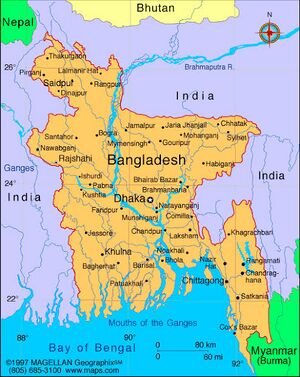Kantanagara
| Author:Laxman Burdak, IFS (R) |

Kantanagar (कंतनगर) is a village in in Dinajpur, Bangladesh.
Origin
Variants
- Kantanagar (कंतनगर) (जिला दिनाजपुर, बंगाल) (AS, p.122)
Kantanagar Temple
Kantanagar Temple, commonly known as Kantaji Temple or Kantajew Temple (Bengali: কান্তজীউ মন্দির) at Kantanagar,[1] is a late-medieval Hindu temple in Dinajpur, Bangladesh. The Kantajew Temple is one of the most magnificent religious edifices belonging to the 18th century. The temple belongs to the popular Hindu Kanta or Krishna and this is most popular with the Radha-Krishna cult (assemble of memorable love) in Bengal. This beautiful temple is dedicated to Krishna and his wife Rukmini. Built by Maharaja Pran Nath, its construction started in 1704 CE and ended in the reign of his son Raja Ramnath in 1722 CE.[2][3] It boasts one of the greatest examples on terracotta architecture in Bangladesh and once had nine spires, but all were destroyed in an earthquake that took place in 1897.[4]
History
कंतनगर
विजयेन्द्र कुमार माथुर[5] ने लेख किया है ... कंतनगर (AS, p.122) बंगाल राज्य के दीनाज़पुर ज़िले में स्थित था। नौविमानों वाले एक भव्य मंदिर के लिए कंतनगर उल्लेखनीय है। यह मंदिर मध्ययुगीन है।
कांतनगर
विजयेन्द्र कुमार माथुर[6] ने लेख किया है ... कांतनगर (AS, p.158): बंगाल राज्य के दीनाज़पुर ज़िले में 1704-22 ई. में निर्मित कांत का मंदिर उल्लेखनीय है. यह मंदिर गौड की मध्ययुगीन (14वीं-15वीं शती) वस्तु शैली में बना हुआ है.
External links
References
- ↑ Ghosh, P. (2005). Temple To Love: Architecture And Devotion In Seventeenth-Century Bengal. Indiana University Press. p. 46. ISBN 978-0-253-34487-8.
- ↑ Husain, ABM (ed.). Architecture: A History Through the Ages. Cultural Survey of Bangladesh Series. Volume 2. Asiatic Society of Bangladesh. p. 243. OCLC 298612818.
- ↑ Ahmed, Nazimuddin (2012). "Kantanagar Temple". In Islam, Sirajul; Jamal, Ahmed A. Banglapedia: National Encyclopedia of Bangladesh (Second ed.). Asiatic Society of Bangladesh.
- ↑ Journey plus - Dinajpur
- ↑ Aitihasik Sthanavali by Vijayendra Kumar Mathur, p.122
- ↑ Aitihasik Sthanavali by Vijayendra Kumar Mathur, p.158

